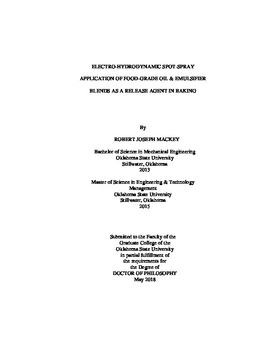| dc.contributor.advisor | Bowser, Timothy | |
| dc.contributor.author | Mackey, Robert Joseph | |
| dc.date.accessioned | 2019-03-25T21:13:38Z | |
| dc.date.available | 2019-03-25T21:13:38Z | |
| dc.date.issued | 2018-05 | |
| dc.identifier.uri | https://hdl.handle.net/11244/317717 | |
| dc.description.abstract | In industrial baking, vegetable oil is used as a release agent for bread depanning. The conventional process of applying oil uses pressure and shear to atomize the oil. This works but generates over-spray and, thus, creates a sanitation problem and a potential food safety risk. The objective of this research project is to determine if the four major commercially available vegetable oils (Palm oil, Soybean Oil, Rapeseed oil, Sunflower Oil) can be made, by the introduction of an emulsifier/surfactant, to carry an electrical charge greater than the Rayleigh point so that they can be electro-hydrodynamically (EHD) atomized. Coulombic attraction pulls the atomized liquid to the target without the problem of over-spray. To accomplish this, each base oil was blended with a surfactant (Lecithin, Polysorbate, Propylene Glycol) at concentrations of 5% and 10%. The solution was sprayed through a capillary tube (19ga, 22ga) in a spot spray mode onto oil sensitive paper at 25kV and 50kV at varying temperatures and pressures. An ANOVA of the DOE structured experiment was performed to analyze the inputs (concentration, voltage, temperature, and pressure) relative to the outputs (droplet count, droplet size, coverage area, and sample weight) to determine the performance of the experiment at different interaction points. | |
| dc.description.abstract | Twenty-four separate experiments involving 865 individual tests provided the data to determine EHD viability for each oil and emulsifier blend. The criteria of average droplet count >200/in2, average droplet size <1mm2, average coverage area between 15%-60%, and average sample weight <0.2g was used as a minimum target for success. Every experimental group tested with a 22ga capillary tube met or exceeded the target. Tests using the 19ga capillary produced generally poor results. From this, it was determined that energy density relative to mass flow was a determining factor in successful EHD atomization. Energy density relative to mass flow, at the given input 2.5 and 5 Joules followed the exponential regression of respectively Ed=6m^(-1.004)�10^2 and Ed=6m^(-1.004)�10^4 respectively. Based on the success of all four base oils with all three emulsifiers, it is reasonable to assume that other oils/emulsifiers might follow the same energy density curve. | |
| dc.format | application/pdf | |
| dc.language | en_US | |
| dc.rights | Copyright is held by the author who has granted the Oklahoma State University Library the non-exclusive right to share this material in its institutional repository. Contact Digital Library Services at lib-dls@okstate.edu or 405-744-9161 for the permission policy on the use, reproduction or distribution of this material. | |
| dc.title | Electro-hydrodynamic spot-spray application of food-grade oil and emulsifier blends as a release agent in baking | |
| dc.contributor.committeeMember | Weckler, Paul | |
| dc.contributor.committeeMember | Wang, Ning | |
| dc.contributor.committeeMember | Collins, Terry | |
| osu.filename | Mackey_okstate_0664D_15595.pdf | |
| osu.accesstype | Open Access | |
| dc.type.genre | Dissertation | |
| dc.type.material | Text | |
| thesis.degree.discipline | Biosystems and Agricultural Engineering | |
| thesis.degree.grantor | Oklahoma State University | |
